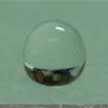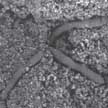Showing Spotlights 601 - 608 of 625 in category All (newest first):
 In order to survive, biological systems need to form patterns and organize themselves. Scientists at the Max Planck Institute for Colloids and Interfaces (MPI-KG) in Potsdam, Germany, have now combined self-organization with chemical pattern formation. They demonstrated that oscillating reaction patterns like that of a Belousov-Zhabotinsky reaction can not only be generated in a one-phase system like in all previous examples but also in a two-phase system like liquid-solid.
In order to survive, biological systems need to form patterns and organize themselves. Scientists at the Max Planck Institute for Colloids and Interfaces (MPI-KG) in Potsdam, Germany, have now combined self-organization with chemical pattern formation. They demonstrated that oscillating reaction patterns like that of a Belousov-Zhabotinsky reaction can not only be generated in a one-phase system like in all previous examples but also in a two-phase system like liquid-solid.
Jul 12th, 2006
 Superhydrophobic surfaces, such as lotus leaves, with micro/nano combined structures found in nature have attracted a lot of interest because of their importance in fundamental research and practical applications such as self cleaning, anti-fogging/snowing, drag reduction effect etc. In this regard, diverse methods have been proposed to produce such surfaces. However, most of the reported methods in the literature generally require a cleanroom-based process or complex chemical processes and have some limitations in terms of mass-production capability and material selectivity.
Superhydrophobic surfaces, such as lotus leaves, with micro/nano combined structures found in nature have attracted a lot of interest because of their importance in fundamental research and practical applications such as self cleaning, anti-fogging/snowing, drag reduction effect etc. In this regard, diverse methods have been proposed to produce such surfaces. However, most of the reported methods in the literature generally require a cleanroom-based process or complex chemical processes and have some limitations in terms of mass-production capability and material selectivity.
Jul 11th, 2006
 The color of metal colloids is highly dependent on their size and therefore being able to control the size is very important to tune the metal colors systematically. By controlling the wavelength of optical resonance of metal nanoparticles and their composition, researchers in South Korea have found a way to fabricate various colored metal colloids both easily and reproducibly. These findings could be very useful for biological assays.
The color of metal colloids is highly dependent on their size and therefore being able to control the size is very important to tune the metal colors systematically. By controlling the wavelength of optical resonance of metal nanoparticles and their composition, researchers in South Korea have found a way to fabricate various colored metal colloids both easily and reproducibly. These findings could be very useful for biological assays.
Jul 10th, 2006
 The mass production of nanoelectronic devices has been hampered by difficulties in aligning and integrating the millions of nanotubes required for the job. Now, researchers in South Korea have developed a method to precisely assemble and align single-walled carbon nanotubes (SWCNTs) onto solid substrates without relying on external forces such as electric or magnetic fields. This result could be an important guideline for the large-scale directed-assembly of integrated devices based on SWCNTs.
The mass production of nanoelectronic devices has been hampered by difficulties in aligning and integrating the millions of nanotubes required for the job. Now, researchers in South Korea have developed a method to precisely assemble and align single-walled carbon nanotubes (SWCNTs) onto solid substrates without relying on external forces such as electric or magnetic fields. This result could be an important guideline for the large-scale directed-assembly of integrated devices based on SWCNTs.
Jul 5th, 2006
 Applying atomic layer deposition (ALD) to biological macromolecules opens a route to fabricate metal oxide nanotubes and thin films with embedded biomolecules. The combination of biomaterials and ALD does not yet allow for a construction of a device. However, there are some indications that the synthesis of thin films with embedded functional biomolecules, such as ferritin, might be suitable for e.g. flexible electronics.
Applying atomic layer deposition (ALD) to biological macromolecules opens a route to fabricate metal oxide nanotubes and thin films with embedded biomolecules. The combination of biomaterials and ALD does not yet allow for a construction of a device. However, there are some indications that the synthesis of thin films with embedded functional biomolecules, such as ferritin, might be suitable for e.g. flexible electronics.
Jun 29th, 2006
 The scientific interest in magnetic nanostructures, both from a fundamental viewpoint and also due to their potential in a wide range of applications, over the past few years has led researchers to develop various nanofabrication methods for synthesizing nanomagnets. Applications for nanomagnetic materials include non-volatile magnetic random access memory (MRAM), highly sensitive magnetic field sensor, field programmable spin logic, and patterned media for ultra high density data storage.
The scientific interest in magnetic nanostructures, both from a fundamental viewpoint and also due to their potential in a wide range of applications, over the past few years has led researchers to develop various nanofabrication methods for synthesizing nanomagnets. Applications for nanomagnetic materials include non-volatile magnetic random access memory (MRAM), highly sensitive magnetic field sensor, field programmable spin logic, and patterned media for ultra high density data storage.
Jun 20th, 2006
 A newly developed electrostatic force directed assembly (ESFDA) technique is used to efficiently coat carbon nanotubes (CNTs) with nanoparticles. This new method advances the current technology by enabling rapid and in-situ coating of CNTs, multicomponent hybrid nanostructures, more control over the assembly process, and the possibility of tuning properties of the resulted hybrid structures.
A newly developed electrostatic force directed assembly (ESFDA) technique is used to efficiently coat carbon nanotubes (CNTs) with nanoparticles. This new method advances the current technology by enabling rapid and in-situ coating of CNTs, multicomponent hybrid nanostructures, more control over the assembly process, and the possibility of tuning properties of the resulted hybrid structures.
Jun 7th, 2006
 NanoFermentation is the first system to use industrial bioprocessing methods to manufacture nanometer-scale inorganic engineering materials rather than organic compounds. NanoFermentation harnesses the natural metabolic processes of metal-reducing bacteria to create tailored, single-crystal nanoparticles of important engineering materials, particularly ferrites.
NanoFermentation is the first system to use industrial bioprocessing methods to manufacture nanometer-scale inorganic engineering materials rather than organic compounds. NanoFermentation harnesses the natural metabolic processes of metal-reducing bacteria to create tailored, single-crystal nanoparticles of important engineering materials, particularly ferrites.
Jun 5th, 2006
 In order to survive, biological systems need to form patterns and organize themselves. Scientists at the Max Planck Institute for Colloids and Interfaces (MPI-KG) in Potsdam, Germany, have now combined self-organization with chemical pattern formation. They demonstrated that oscillating reaction patterns like that of a Belousov-Zhabotinsky reaction can not only be generated in a one-phase system like in all previous examples but also in a two-phase system like liquid-solid.
In order to survive, biological systems need to form patterns and organize themselves. Scientists at the Max Planck Institute for Colloids and Interfaces (MPI-KG) in Potsdam, Germany, have now combined self-organization with chemical pattern formation. They demonstrated that oscillating reaction patterns like that of a Belousov-Zhabotinsky reaction can not only be generated in a one-phase system like in all previous examples but also in a two-phase system like liquid-solid.
 Subscribe to our Nanotechnology Spotlight feed
Subscribe to our Nanotechnology Spotlight feed
